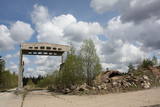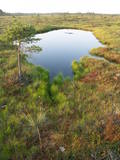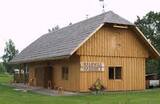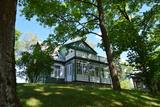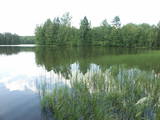| Nr | Nosaukums | Apraksts |
|---|---|---|
|
Brīvdienu māja "Jasmīnu nams" atrodas pie pašas Jelgavas robežas - tikai 7 minūšu braucienā līdz pilsētas centram. Brīvdienu māja ir lieliska vieta mierpilnam dabas baudījumam, kas rit roku rokā ar iespēju stiprināt veselību pirtī vai alternatīvā SPA - āra kublā. Brīvdienu mājā ir 3 istabas, savrupa teritorija vienai līdz divām mājsaimniecībām – līdz 6 personām, īpašu uzsvaru liekot uz atpūtu kopā ar bērniem. Nav paredzēts skaļām ballītēm un jauniešu tusiņiem. Namiņā ir viss nepieciešamais maltītes pagatavošanai gan iekšā, gan ārā svaigā gaisā. Tuvumā atrodas Svētes upe un atpūtas zona - Svētes palienes pļavu koka laipu celiņu tīkls. |
||
|
Atrodas Kaibēnu kalnā (226 m v.j.l.) – 7 km uz rietumiem no Inešiem. Nominēts kā Latvijas vecākais (no 1929. g.) memoriālais muzejs. „Kalna Kaibēnu” ēkas ir celtas laika posmā no 18. – 19. gs., un tajās apskatāmi tautskolotāju un rakstnieku Reiņa (1839. – 1920.) un Matīsa (1848. – 1926.) Kaudzīšu pašu būvētā veranda, kāpnes, sienas skapji, parketa imitācijas un R. Kaudzītes izveidotā ratiņu virpotava. Ratnīcā ir izvietota seno darba rīku kolekcija. Autentisko viensētu ieskauj rakstnieku stādītais dārzs ar koktēlnieka K. Kugras veidotajiem romāna “Mērnieku laiki” tēliem. „Kalna Kaibēnos” tapis leģendārais romāns „Mērnieku laiki”. Laikā no 1868. – 1882. g. dzīvojamā ēkā atradusies pagastskola, kurā Matīss strādāja par skolotāju, bet Reinis – par skolotāja palīgu. Muzeju ieteicams apskatīt gida pavadībā. |
||
|
Onions, fish, villages that stretch out for several kilometres where the buildings are lined along the main street, ornate Old Believers' churches, small harbours with fishing boats and wooden houses, each painted in a different colour! Cafés, shops and a view of Lake Peipus, which looks more like a sea than a lake. This could be the description of this tour. This tour is a very interesting part of the Forest Trail, which will give you an opportunity to see and enjoy the Lake Peipsi region, the culture and lifestyle of local people as well as the nature. The tour will start in Tartu – Estonia’s second biggest city. You will go by bus from Tartu to Varnja where you will start to hike. During the tour you can visit Kostja’s onion farm, where the host welcomes guests and presents onion cultivation. It is also worth visiting the Chicory Museum in Kolkja to get acquainted with the history of chicory cultivation in row villages near Lake Peipus. You will also see Alatskivi Castle. In Avinurme we suggest visiting the Avinurme wooden handicraft centre and get acquainted with the local woodcraft, spend quality time in woodworking workshops and taste or even prepare yourself a selection of Estonian traditional foods. At the end of the tour you will return to Tartu by bus. |
||
|
Piedāvājumā ir zirgu izjādes un izbraucieni pajūgā visa gada garumā. Apmeklētāji var rast saskarsmi ar dzīvniekiem – kazām, aitām, vistām, tītariem, zosīm un pīlēm. Kūpināta kazas siera degustācija. Saimniece taisa ziemassvētku puzurus u.c. rotājumus. |
||
|
Knīpupju kuģu un krasta apsardzes raķešu remontdarbnīcas Liepājas rajona Bārtas mežos ir vizuāli patiesi ļoti iespaidīgs bijušais PSRS militārais objekts. Teritorija šobrīd atrodas novada pārvaldībā, ēkas tiek demontētas būvmateriālu ieguvei un šobrīd izskatās nožēlojamā stāvoklī. Ja šis objekts būtu saglabāts un pasargāts no šāda veida rīcībām, tas tūrisma ziņā varētu būt bijis viens no Kurzemes interesantākajiem bijušās PSRS armijas militārajiem objektiem.
|
||
|
Naissāre ir viena no Igaunijas mazajām salām, kas periodā no II Pasaules kara beigām līdz 1993. gadam atradās Padomju armijas pārziņā. Savulaik - slepens padomju militārais objekts. Interešu objekti uz salas ir pastaigu takas, sugām bagātā daba, šaursliežu dzelzceļš, cara laika lielgabalu baterijas un jau minētās armijas jūras mīnu rūpnīca. No Tallinas uz Naissāri kursē kuģītis “Monica”. |
||
|
Kafejnīca Roomassaare atrodas netālu no Kuressaare, no kuras paveras gleznains skats uz Roomassaare jahtu piestātni. Vasaras sezonā kafejnīcā pārsvarā gatavo maltītes no vietējiem produktiem, piedāvājot gan saliniekiem, gan tūristiem vienkāršu un tīru vietējo garšu kombināciju. Bez zivīm nekādi! |
||
|
Kaut arī teritorija ir veidota Latvijā reti sastopamas koku sugas - parastā skābarža aizsardzībai (tīraudzes aizņem ap 4 % no lieguma teritorijas), tās vizuāli izteiksmīgākā daļa ir Tīrspurvs (Dunikas tīrelis), kurā šobrīd izveidota Latvijas garākā un viena no iespaidīgākajām purva laipu takām, šķērsojot to Z – D virzienā. Te var gūt fantastiskus iespaidus, vērot savdabīgo purva vidusdaļas ainavu (vietām nav pat mazo purva priedīšu) un dažādus biotopus - purva ezeriņus, minerālzemes salas, lāmas, akačus un putnus. |
||
|
Muzejs (dibināts 1944. g.) atrodas Skolas ielā 10. Tas ir viens no vecākajiem Vidzemes muzejiem, kura interesantākie eksponāti ir atradumi no vidējā un jaunākā dzelzs laikmeta, kas daļa ir nākuši no Lubānas ezera apkārtnes. Muzeja darbinieki organizē gan tematiskas izstādes, kas saistītas ar novada kultūrvēsturi, gan mākslas izstādes. Muzejs izvietots bijušās Biržu muižas vēsturiskajās ēkās. |
||
|
Nakšņošana lauku mājā līdz pat 40 personām (ar papildvietām). Pirts un pirtnieka pakalpojumi, svinību telpa, atpūta dabā – peldvieta dīķos, makšķerēšana, sporta un atpūtas laukumi. Saimnieki piedāvā nobaudīt žāvētas zivis vai zivju zupu, arī no Jūsu pašu iegūtā loma. Makšķerēšanai ir pieejami 17 zivju dīķi. "Paradīzēs" ir iespējams rīkot arī svētku svinēšanu brīvā dabā, kā arī nakšņot teltīs. Viesošanās Viesu namā "Paradīzes" iepriekš obligāti ir jāpiesaka! |
||
|
Viena no lielākajām Latvijas peoniju kolekcijām, kur peoniju šķirņu skaits ir gandrīz sasniedzis četrus simtus. Augu kolekcionāre un audzētāja Dagnija Voika ir izveidojusi dārzu, kurā ir ap 30 šķirņu krūmpeonijas, lielziedu bārdainie īrisi, Sibīrijas īrisi, dienziedes, kā arī mazāk pazīstami košumaugi - jukas un eremūri. Pieņem viesus peonijas ziedēšanas laikā - jūnijā, rīko Peoniju ziedu svētkus, un vada ekskursijas. Apmeklētāji var iegādāties peoniju stādus un dāvanu kartes. Jaunais stādu katalogs ir pieejams no 1. marta.
|
||
|
Namdara darbnīcā piedāvā īpašas ekskursijas un pasākumus pieaugušajiem un bērniem, ir izveidotas tematiskas programmas. Meistaru vadībā var darboties ar tradicionālajiem kokapstrādes instrumentiem un apgūt senās spēles, noslēgumā cienāties ar spēka tēju un piknikot romantiskajā Ugunskura namā. Var iegādāties koka suvenīrus un veikt pasūtījumus. |
||
|
A. Baranauska un A. Vienoļa – Žukauska memoriālais muzejs izveidots 1927.gadā. Tajā tiek vāktas, glabātas un popularizētas muzeja vērtības, kas atspoguļo Anīkšču apkaimes kultūras, literatūras, vēstures, agrokultūras, tehniskās vēstures attīstību. Visas sezonas laikā apmeklētāji var pastaigāties pa Rakstnieku kalniņa memoriālo parku. |
||
|
Jaunpils ūdensdzirnavas ir industriālā tūrisma apskates objekts, kurā ir saglabājusies dzirnavu iekārta, kas darbojusies 20. gs. 20.−30. gados, kā arī hidrotehniskās būves un ūdenskrātuve. Šobrīd dzirnavās ir izveidota ekspozīcija par pašām dzirnavām, malšanas procesu un graudkopību. |
||
|
Pašā Lahemā nacionālā parka vidū atrodas savdabīga vieta – Jānioja rokdarbu sēta. Ar akmeņiem apmalotais ceļš aizvedīs līdz dzeltenai saimnieku mājai, kur netālu atrodas telšu laukums un ugunskura vieta, savdabīga lauka virtuve, veca, liela baļķu māja, pirts un smēde.Rokdarbu sētā tiek rīkotas radošās nometnes, rokdarbu kursi, pasaku iestudējumi, gadskārtu ieražu svētki un meistarošana visai ģimenei.Pārdošanā ir tepat darinātās lupatu lelles mirdzošām acīm, mamzeles Janikas lupatu vamži un citi savdabīgi rokdarbi. |
||
|
Mūsdienās redzamais iespaidīgais dievnams tapis ilgākā laika posmā. Jau 1870. g. latviešu draudze sāka vākt ziedojumus neogotiskās baznīcas celtniecībai, ko pabeidza 1904. gadā (V. Neimaņa projekts). Ēkas iekšpusi rotā dekoratīvi zvaigžņu velvju griesti, bet tās altārdaļā izvietotasmākslinieka J. Šķērstena veidotās vitrāžas (1940. g.) un 17. gs. kristāmtrauks. Baznīcu ieskauj plašs dārzs. |
||
|
Viens no dažiem Latvijas dzidrūdens ezeriem. Apskatāms no Lubānas - Ļaudonas ceļa malas pie Visagala. Lai saudzētu šo ezeru, tajā esošos aizsargājamos biotopus un sugas, ūdenstilpē nevajadzētu peldēties lielām cilvēku masām un pieļaut cilvēka darbības produktu nonākšanu ezerā.
|
||
|
Keramiķe piedāvā izglītojošas nodarbības, kuru laikā paši var veidot māla izstrādājumus un tos izdedzināt. Studijā tiek gaidītas gan bērnudārzu audzēkņu un skolēnu grupas, gan pieaugušie un senjori. Keramiķei ir pieredze strādāt ar cilvēkiem, kam ir īpašās vajadzības. Studijā var iegādāties jau gatavus māla izstrādājumus. |
||
|
Maršruts ved no Latvijas galvaspilsētas Rīgas, caur skaistajām lauku teritorijām uz Kauņu, kas ir otrā lielākā Lietuvas pilsēta. Klūgu ainavu dārzs un parks ir slavens ar begonijām. Dobeles dārzkopības institūtā ir vairāk nekā 200 ceriņu augu veidu un formu kolekcija. Skaisto un praktisko ideju dārzs lepojas ar savu skujkoku kolekciju, un viesiem piedāvā garšvielu pulverus, žāvētas ogas un augļus. "Rūķīšu tēja" ir viena no lielākajām Latvijas ārstniecības augu saimniecībām (audzē kliņģerītes, kumelītes utt.) Kroņaucē sezonas laikā baudiet peoniju skaistumu Andra Berkina kolekcijas dārzā un krāšņo Viestardu tulpju dārzu. Nākamā pietura atrodas zemnieku saimniecībā "Droši vesels", kas ražo augu izcelsmes ziedes un audzē dārzeņus. Apmeklējot Piparmētru namiņu, jūs varat izbaudīt piparmētru tēju, cepumus, medu ar piparmētrām un piparmētru sīrupus. Blankenfeldes muižā jūs varat aplūkot unikālo zvanu kolekciju un izbaudīt dabīgās sulas, sīrupus un marinētus gurķus, kas ražoti muižā. Joniškos apmeklējiet sarkano un balto Jonišku sinagogu, Sv. Jaunavas Marijas debesīs uzņemšanas baznīcu un Jonišku vēstures un kultūras muzeju. Jakiškiai muiža nav renovēta un saglabājusi autentiskus elementus, kā piemēram, krāsnis, slēģus, kāpnes, durvis. Baltijas Augu muzejā audzē aptuveni 30 dažādu sugu un šķirņu augus. Šauļu Botāniskajā dārzā izveidoti trīs seno augu dārzi atbilstoši lauku tradīcijām attiecīgajā periodā – pirmskara, starpkaru un pēckara. Burbišku muiža ar tās skaisto ainavu un skulptūru parku organizē ikgadējo tulpju festivālu. Kleboniškių lauku māju muzejā var aplūkot autentiskas Augštaitijas reģiona saimniecības. Baisogalas muižu sauc par karalisko, jo tā kādreiz piederēja Lietuvas lielhercogam, un tās 12 hektāru parks ir viens no skaistākajiem Lietuvā. Slavenā lietuviešu dzejnieka Mačiulis-Maironis muzejā ir divi skaisti kultūrvēsturiskie dārzi. Mājas ražotos "laimīgos ēdienus" var iegādāties no Garsi Tyla saimniecībā, un iespējams doties pastaigā to 100 gadu senajā augļu dārzā un apskatīt garšaugu dārzu. Lietuvas Dārzkopības institūts veic gan zinātniskās, gan eksperimentālās / ražošanas aktivitātes. Šeit varat nopirkt stādus, kā arī sezonas augļus un dārzeņus. Tadas Ivanauskas saimniecībā pie Obelynes parka jūs redzēsiet 300 sugu un augu šķirņu kolekciju, ieskaitot vecāko koku divdaivu ginku. Kauņā Lietuvā varat apskatīt vecāko ābeli - gandrīz 360 gadus senu, 8 metrus garu, 285 cm diametrā ap 1.3 metru augstumā. Vytautas Dižā Universitātes Kauņas Botāniskais dārzā aug unikāli augi, ierīkota lielākā oranžērija Lietuvā, senie Lietuvas puķu dobju augi tiek demonstrēti dažādās augu kopās atbilstoši botāniskajai klasifikācijai. Maršruts beidzas Kauņā, kas bija Lietuvas galvaspilsēta no 1920. gada līdz 1939. gadam. |
||
|
Šī maršruta apkārtnē norisinājušies daudzi notikumi, kas tieši saistīti ar Latvijas valsts tapšanu un Brīvības cīņām. Vēsturisko ceļu no Rīgas uz Liepāju cauri Dobelei, Saldum, Skrundai, Durbei un Grobiņai var izsekot jau no seniem laikiem, pat sākot no 13. gadsimta. Kurzemē vienmēr ēduši jūras, upju un ezeru zivis, it īpaši kūpinātas. Novada ēdiens ir māla podiņā gatavota kūpināta menca ar piedevām. Sezonas gardums ir salakas un vēja zivis, bet brētliņas, siļķes un lasis pieejami visu gadu. Saimnieces cep rudzu ierauga rupjmaizi, saldskābmaizi un gardus sklandraušus, cienā ar miežu putraimu skābputru vai bukstiņputru. Nozīmīga loma ir piena produktiem, Jāņu sieram un “baltajam sviestam”. Svaigo govs piena sieru gatavo arī ar dillēm un ķiplokiem, tāpat gards ir kazas piena siers. Ēdienkartē netrūkst vietējo mājputnu un mājlopu gaļas ēdienu: cepeši, ribiņas, desiņas, var dabūt arī cūkas mēli un buļļa pautus. Smalkos krogos piedāvā fazānu un medījumus, papildinātus ar sēnēm un brūklenēm, kadiķogām un savvaļas garšaugiem. Kurzemē jūs sagaidīs ar gardiem pīrāgiem, plātsmaizēm, magoņmaizītēm un medus kūkām, cepumiem ar magonēm un dzērvenēm, saldēdienu no rudzu rīvmaizes, brūklenēm vai dzērvenēm un saldā krējuma. Iecienītas ir melleņu klimpas. Neparastāki ir gardumi no savvaļas augiem – marmelāde no pīlādžiem, dzērvenēm un pat skujām. Slāpes veldzēs smaržīgas zāļu tējas ar medu. Reibinoši mirkļi piedzīvojami pie alus kausa un mājas vīnu degustācijās. |
||







